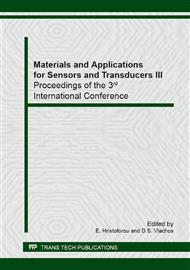p.87
p.91
p.95
p.99
p.103
p.107
p.111
p.115
p.119
Fabrication of Infrared Detector Based on of Polyaniline/Polyvinylidene Fluoride Blend Films and their Pyroelectric Measurement
Abstract:
Infrared detection based on polymeric materials is continuously developed in order to be cheap and easy to processing and also having high pyroelectric coefficient to convert heat to electrical signal. PANI/DBSA was blended with polyvinylidene fluoride (PVDF) with different weight ratios to improve pyroelectric coefficient and electrical conductivity of PVDF. The temperature dependence of the electrical conductivity is measured in the range of 20-100 °C It was found that the pyroelectric coefficient increased from 1.5×10-8 C/m2 °C for pristine PVDF to 2.61×10-5 C/m2 °C at 25 wt.% PANI at 30 °C. The infrared detector circuit connected to the gate of a voltage follower JFET with high input impedance was designed to convert the high output impedance of the sensor into the output resistance. The output from the sensor and JFET is amplified in two stages of operational amplifier with high voltage gain with low noise.
Info:
Periodical:
Pages:
103-106
Citation:
Online since:
April 2014
Authors:
Price:
Сopyright:
© 2014 Trans Tech Publications Ltd. All Rights Reserved
Share:
Citation:


